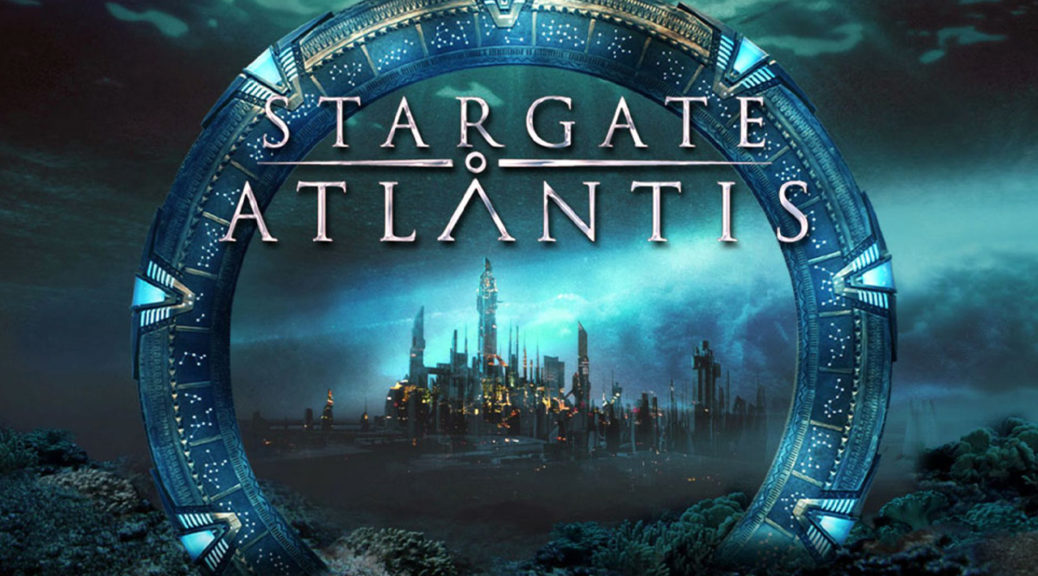EXPLORING OTHER GALAXIES – STARGATE ATLANTIS
With the success of Stargate SG1 the producers started to think of ideas on how to expand the Stargate universe. They started coming up with several different ideas on how to continue the franchise. The initial idea was that SG1 would end and the spin off would pick up where it left off. The SGC would have relocated to an ancient base under Antarctica and the series would have taken place in our galaxy still. When they realized that there was no way they were going to be able to wait for SG1 to finish because it kept getting renewed, they decided to run both series concurrently and move the Atlantis series to another galaxy.
Moving the series to the Pegasus Galaxy freed the producers and writers up to tell different stories and introduce new and different races and cultures that were not bound by the canon that SG1 had established. It also meant that they needed to establish a new antagonist species to the series. They didn’t want to re-tread old ground on the type of enemy they had for Atlantis– they wanted something different from the Goa’uld. The Wraith were the result. Vampiric in nature, the Wraith feed upon human beings- draining their life energy and absorbing it into themselves. This makes them incredibly resilient to damage and allows them to heal quickly (especially if they have just recently fed). It was decided that the Wraith would have a matriarchal society with Queens being the top of the chain, much like bees. They took a lot from the hierarchy of bees in designing the Wraith.
When it came to creating the new main characters to lead the series, they knew that they needed military personnel to fight the enemies they would face; but also that this was a civilian expedition primarily. Elizabeth Weir was introduced in the Season 7 finale of Stargate SG1, The Lost City. She was initially played by Jessica Steen, however, when it came to the Atlantis series, Steen was replaced by Torri Higginson. Steen had been told that her character might carry on into the spin-off and she was paid to not take any additional work until the decision whether or not to greenlight Atlantis was made. When the series was greenlit, they decided to go with a different actress; Steen was never informed why this was, she was just informed that they would be replacing her as Weir.
Torri Higginson’s approach to Weir was different to Jessica Steen’s, Higginson played her a little stiffer and more professional in her approach, whereas Steen’s Weir always came across as a little more casual. Despite the more professional Weir, she was able to cut loose and have fun however; as the leader of the Atlantis expedition, she quickly adapted to a more militaristic view of how things had to be run when they encountered the Wraith. Because there was a bigger split of military and civilian personnel in Atlantis, Weir had the difficult task of arbitrating between the two parties. The character was set up to be an expert negotiator and her position as leader of the Atlantis expedition made total sense with this background as she would be in charge of two very different groups of personnel. Her experience with military and civilian personnel alike became invaluable in her role. Finding herself in the position to make a military decision over a scientific one created a real sense of tension and drama putting her on the outside of both parties at times.
Towards the end of Season 3, the producers started to feel like there wasn’t a lot that they could do with the Weir character; they were running out of ideas for where to take her They made the decision to reduce the role to a recurring one. At the end of the last day of shooting the Season 3 finale, Higginson was called up into the producers’ office and she was informed that they were cutting her role to a recurring one. Higginson was not pleased with the news or how they had handled it, and rather than accept the reduced role ,she decided to walk away. She agreed to return for four episodes of Season 4 to finish off the character’s arc, however when they wanted her to return for a guest role in Season 5, she refused. Her decision to walk away was primarily due to how they had broken the news to her that she was going to be a reduced role. She had also felt like her character was being under-utilized in the series and would often spend days just standing in the background.
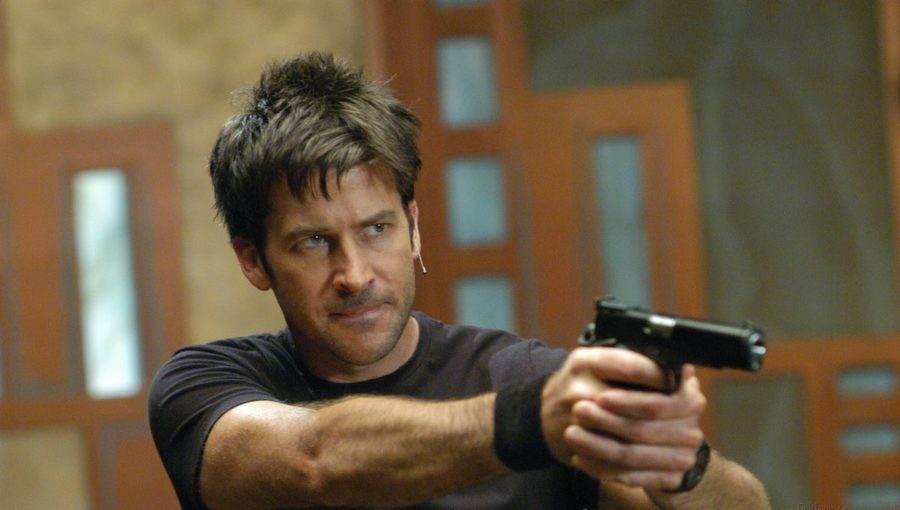
The military commander of Atlantis was a hard role to cast. The producers wanted Ben Browder for the role, but due to his commitment to Farscape: The Peacekeeper Wars, he was unavailable. They auditioned several other actors for the role and couldn’t find anyone who fit the bill. By chance, an MGM official had approached Joe Flanigan’s agent at an award ceremony. Another actor who he represented had just won an award and in congratulating him, the MGM official asked if he knew anyone who could fill a role he was trying to cast. When describing the role, Flanigan’s agent felt like he was describing him, so he arranged a meeting for the next day. After a two-hour meeting in the morning he was cast by the afternoon. Flanigan had initially turned down the role though because he didn’t feel like he could be in a Science Fiction TV series- he didn’t think he was good enough to be so serious. Because he hadn’t seen Stargate SG1 he didn’t realize was that they wanted the character to have a sense of humor. What really appealed to Flanigan was not just the sense of humor the Stargate franchise had- but how it had fun with the Science Fiction genre and didn’t take it 100% seriously. The sense of humor of the show really made it an enjoyable experience for Flanigan because they were able to reference other Science Fiction as the characters would be aware of them. As well as the comedy in the series, he also loved shooting the action scenes and would do as many of his own stunts as he could. With the stories that they were telling he loved it when they were able to do stories that were completely different from that of what SG1 had done. When being interviewed during Season 1, Flanigan said that his favorite episodes they had shot so far were the two-part episode The Storm and The Eye because of all the action scenes he got to play. Flanigan liked getting involved in the whole process. When they were casting Ronon Dex, Flanigan flew out to LA to read with the actors who were auditioning and thought that Jason Momoa was the best person for the job. He wanted to write a script at one point but didn’t have the time so instead he came up with a story outline and Brad Wright wrote the screenplay. The episode was Epiphany , but unfortunately it didn’t turn out quite as he imagined it would and he was a little disappointed with it in the end.
John Sheppard was a different lead than that of Jack O’Neill. Whilst they shared some characteristics- like their sense of humour- there were also some real opposites to the characters. O’Neill would bend the rules from time to time, but he never really broke them. Sheppard, on the other hand, had no issues bucking the authority wherever he could and breaking rules. The character had a history of disobeying orders and they explored the consequences of one of these decisions in one of the episodes. Before the pilot aired, people were making comparisons between Sheppard and O’Neill ,but after the premiere of the series the comparisons stopped because it was clear that the characters were completely different. Despite being the military leader, it is revealed early on that Sheppard had passed the MENSA entrance exam, although he didn’t join. His intelligence was one of the main reasons for disobeying orders- he felt that he knew better and, while he was-at times- correct ,there were consequences to these decisions. Flanigan also really wanted to make sure that they were doing things differently to how they had been done on SG1 to really set the series apart from its predecessor.
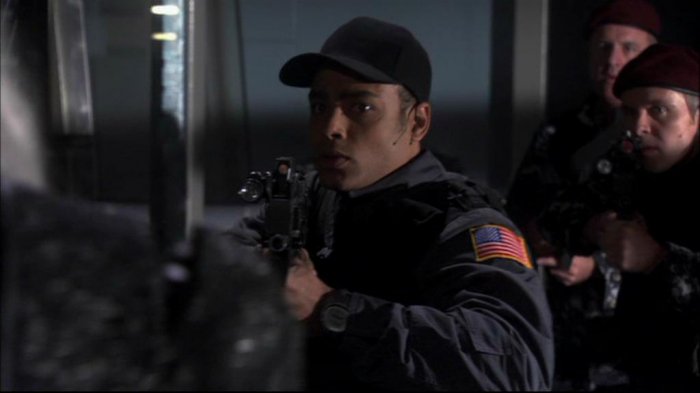
Rainbow Sun Francks submitted an audition via an MPEG video to the producers. Brad Wright talked about watching a tiny video of his audition and struggling to see everything but realizing that he was really good. They brought him in for a proper audition and he was cast as Lt Aiden Ford. Francks was a professed Sci-Fi fan , so being cast in Stargate Atlantis was a dream role for him. Francks talked about the lack of a Ford-centric episode in the first season and felt that whilst he didn’t have a whole episode dedicated to his character, the character was fleshed out a little more in the B or C plots of other episodes, Letters From Pegasus allowed the audience to see a little more of Aiden Ford instead of Lt. Ford. He found it really tough not having much background for his character as he could create some aspects himself but in other places he wasn’t able to create them so it was a tough balance of what was OK for him to do and what wasn’t.
Francks was not kept on as a regular after the end of Season 1. Of the decision, he did say that he was disappointed but- with the direction they took Ford -it was much more interesting to him as he got to play a bad guy. He felt that his character had been a bit of a ‘yes’ man in the first season and having the freedom to play bad was very liberating for the character and for him as an actor. The choice by the producers to write out Ford was down to the reason that they saw the character as the weak link. The character was just there as the gun guy -which is useful for action scenes, but apart from that, there wasn’t much else they could do with the character. They had kind of painted themselves into a corner with him. The choice to make him a villain and bring in Ronon Dex was definitely the best choice they made, as Ford as a villain was way more interesting than he was as the good guy. I only wished they had brought him back a few more times.
Rachel Luttrell had to audition for the role of Teyla Emmagan on five separate occasions before she got the part. Luttrell had a background in dance and music, which seemed an odd choice for such a strong leader as Teyla. However, Luttrell’s dance background helped her in the fight sequences, especially the stick fighting. She was taught the basics by Stunt Coordinator James “BamBam” Bamford and then given a set of the fighting sticks and sent home to practice. She took to it very quickly and was able to pick up a lot of the fighting styles with very little effort. Due to a chance encounter with Ray Park (Darth Maul from Star Wars) at London Comic Con, she got to train with him for a couple of days. He offered to show her a few tricks and, always ready to take on more knowledge, she jumped at the chance.
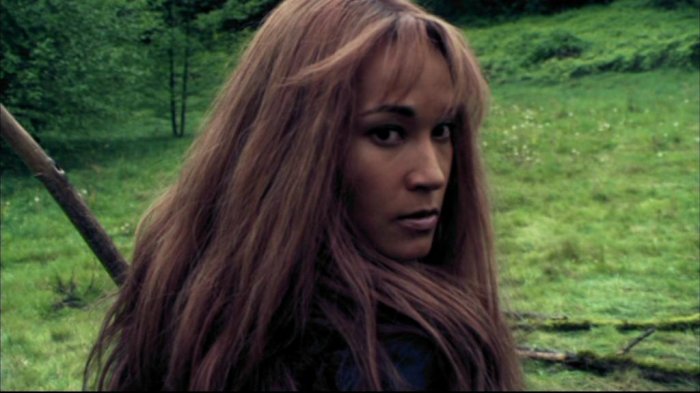
Teyla had an exotic beauty to her as well as a strength in conviction. She never backed down from an argument and would often fight her corner against anyone. Her knowledge of the Pegasus Galaxy provided the Atlantis team with valuable insight when gathering resources and establishing trade, and her knowledge of the Wraith would be invaluable as the series progressed. While her dance background helped with the stunt work she did, including the stick fighting, the producers took advantage of her music background in the episode Critical Mass. Luttrell had to record the song for the episode twice, as the first time it didn’t sound like Teyla, it sounded like Rachel singing and they wanted the vocals to be less refined and a bit more amateur.
Luttrell was a fan of the original Stargate film and had seen a few episodes of SG1. Add to that Teyla’s character description really captured her imagination, she wanted to get the role. The most appealing part of the character was how grounded she was despite being the leader of her people. While initially there was some flirtation between herself and Sheppard that never became anything other than a close friendship which I am glad of. Too often series will just go the relationship route with male and female main characters solely because they are in the main cast. Luttrell talked about the relationship between Teyla and Sheppard in an early interview and she said that although there was flirtation, she felt that it would take something away from the character if she did get into a relationship with Sheppard. Teyla was seen to be the moral compass of the team- she was always the character who would push the others to do the right thing, even if it put herself in harms way.
When Luttrell became pregnant, the writers wrote into the story that Teyla had become pregnant and made it a core story point throughout the fourth season and into the fifth season. The writers wanted to take the character down a darker path as she had always been a noble warrior and they wanted to explore her dark side. They did that in the season 4 episode, Missing, where Teyla is trying to find the Athosians who have been taken. You can see how far she is willing to go to find her people and taking such a noble character to that level was always fun for the writers to explore and interesting for the viewers to experience. It was one of the things that made all the characters so realistic, the fact that they can do something so out of character, it made them more human.

Dr Rodney McKay was first introduced in Season 5 of Stargate SG1 as a one-off character. He was a sexist pig who thought he was way smarter than anyone else; a character the audiences loved to hate. On his second appearance in SG1 they did soften the character and humble him a little. Initially, the character had never been supposed to appear in Atlantis at all- the character was originally called Dr Ingram and was described as an African American character, however they were finding the character incredibly difficult to cast. Filming had already started and they still hadn’t found someone to play Ingram so Martin Wood suggested that they brought the McKay character into the series instead. They contacted David Hewlett to see if he was available and interested in auditioning for Dr Ingram, wanting to keep the McKay idea secret so it didn’t leak out straight away. Just before Hewlett went into his audition, he was informed that it was actually the McKay character and the next day he was on set filming.
David Hewlett was a self-professed science nerd as a child so he loved all the scientific aspects of the character and was actually already reading up on a lot of the things for research. What really appealed to Hewlett about the McKay character was how unlikable he was. Most of the time the regular characters were nice people who the audience liked but McKay was (in the beginning at least), quite unlikeable. Those characteristics were so interesting for him to play as a series regular and slowly have the character evolve and build up friendships and gradually become more likeable over time. Hewlett also enjoyed the fact that McKay was the pessimist voice in the series- everything was always doom and gloom and rested on his shoulders to fix. Even though most of the time he was responsible for getting them into the situation where something needed fixing.
Hewlett had great difficulty learning his lines so a lot of his spare time was taken up with just learning his lines for the next day. Although the technobabble was easier for him to learn as he was always interested in science and liked taking things apart and trying to put them back together again. Despite the role not being a very physical one, Hewlett would always find himself in situations where he was doing some sort of stunt work. In the Season 2 episode Runner, he was suspended by his leg for six hours while they shot the sequence where McKay is snagged in a trap. Not once did Hewlett complain, or vomit, even though it was a bit of a concern at one point when he had to swing himself around as if he was trying to shake loose of the trap.
Some elements of McKay would bleed into his real life, he would return home from a days shooting and his girlfriend would tell him that he has fifteen minutes when he gets home to get McKay out of his system. The mannerisms of McKay would stick around after filming so he would be snapping his fingers and pointing like McKay and his girlfriend would tell him, “Alright , that was Rodney, and you have five minutes now.” In one of the episodes it was revealed that McKay has a sister. Originally it was written as a brother, however as Hewlett had sisters he wanted to change the line to sister. He did have an ulterior motive to the request- one of his sisters is an actress so he hoped that if they ever brought McKay’s sister into the series his real life sister would get the chance to play the part. They did bring her in and Kate Hewlett, David’s real life sister, played Jeannie Miller, McKay’s sister.
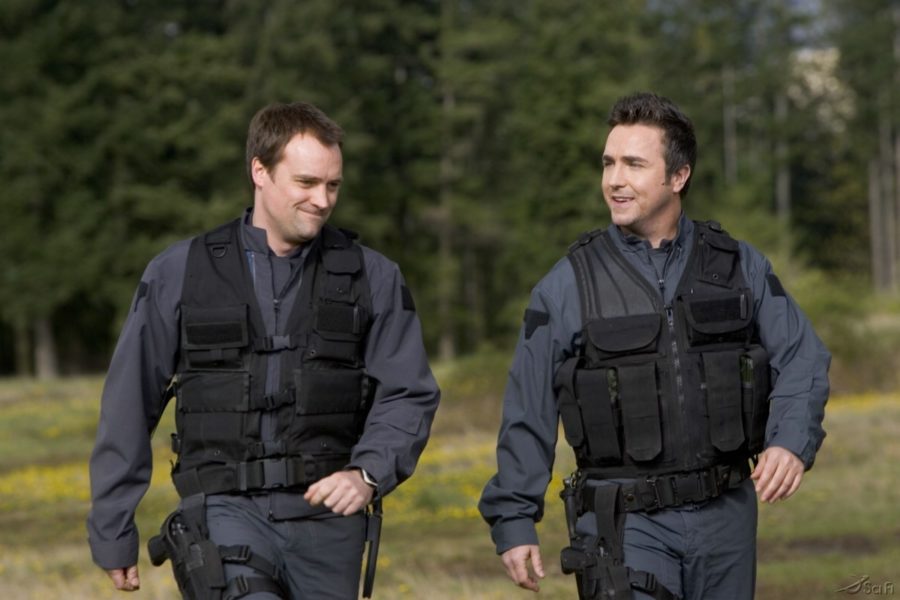
One character who was originally intended to be more of a background character was Doctor Carson Beckett. Paul McGillion had played a small part in the Stargate SG1 season 1 episode, Torment of Tantalus. He had impressed the producers and when they were casting the role of Beckett they remembered him. The character was never written as Scottish, that was something that McGillion brought himself. His accent was so convincing that there are still people to this day who think McGillion was Scottish himself. McGillion’s family was Scottish so he found the accent very easy to do and for any of the medical terminology he would ask his brother, who is a doctor, how he would pronounce the medical jargon in a Scottish accent.
McGillion’s chemistry with the rest of the cast certainly helped the character’s expansion. Of all the characters he had the best chemistry with McKay. The reason for this was that McGillion and David Hewlett struck up a close friendship off screen which translated into an on-screen friendship. The two characters friendship became the highlight of many episodes; their interactions were fan favourite moments within the series. In Season 3, McGillion was promoted to series regular which wasn’t bad at all for a character that was originally intended to just be a background character.
In the shocking Season 3 episode, Sunday, Beckett was killed off giving the Stargate franchise one of it’s most heart wrenching episodes. Some would argue even more so than the SG1 episode, Meridian, where Daniel Jackson ascended. When shooting the episode, McGillion found it incredibly difficult as he knew he was saying goodbye to so many friends. The sequence where Beckett hands over the tumour and it explodes was shot in silence and there was a very sombre mood that day. Fan outcry was huge, a website savecarsonbeckett.com was set up and got a huge amount of traffic. As well as the website a peaceful protest was organised outside the production studios. Fans loved Dr Beckett and they wanted him back. The producers didn’t expect the response from the fans that they got and so they did eventually bring the character back in a recurring role.
When they had made the decision to replace Lt Ford in Season 2, there were several ideas floated around. Brad Wright wanted Ford’s replacement to be a military officer who arrived on the Daedalus, the resident Earth vessel of Atlantis. However, Robert C. Cooper was worried that another Earth military officer would give them the same issues they had with Ford and wanted an alien like they had with Teal’C on SG1. A compromise was met and it would be an alien with a strong military background. That is how Ronon Dex came to be. When they were casting the character, they had Joe Flanigan to run lines with the finalists. According to Brad Wright, when one of the finalists walked in for his audition Wright said to Robert C. Cooper, “If this guy can act then he’s the guy.” It turned out that he could act.
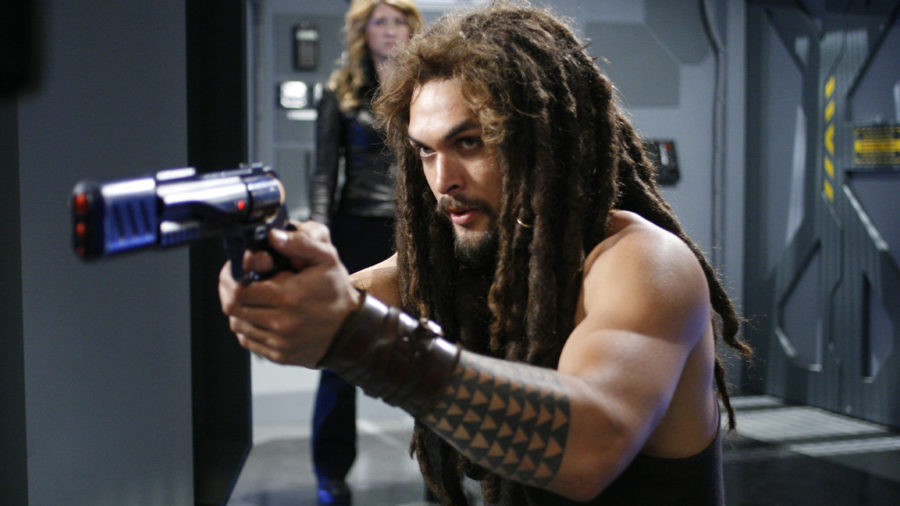
Jason Momoa, the future King of Atlantis, was cast as the resident Chewbacca, Ronon Dex. His 6 foot 4 inch built like a tank appearance crossed with his gruff voice and even gruffer appearance made him stand out in the world of Atlantis. He first appeared in episode three of the second season, Runner, and stayed with the series until it’s end. To an outside observer, Ronon was just a Teal’C clone, however, Ronon has about as much in common with Teal’C as Sheppard does with O’Neill. They are both aliens, they are both tough and they are both men of few words, and that’s where the similarities end. Where Teal’C was very stoic, Ronon had a sense of humour to him which played nicely off of the other characters. He was also the one character you could count on to have a weapon or twenty hidden around their person. In a particularly humourous moment from the Season 2 episode, The Hive, Sheppard asks him how many knives he has hidden on himself and Ronon replies with, “How many do you need?” These were the moments that separated him from the Teal’C comparison and really made the character stand out. If you were on his side he would have your back no matter what. Joe Flanigan talked about how he started referring to the Ronon character as Chewie, but Momoa in an interview said that it was he himself who started calling Ronon ‘Chewie’. Whoever said it first it eventually made its way to the writers who started to have Sheppard call Ronon Chewie whenever he was being particularly aggressive.
To look at Momoa, you would expect that he had been doing action scenes his entire acting career- this was not so. His first ever fight scene was in his first episode of Stargate Atlantis and it was a knife fight. According to James Bamford, the stunt coordinator, Momoa took to the fights like a duck to water. He had a natural talent for the fight scenes and he enjoyed doing it, to the point where he would do as many of his own stunts as possible. Not only did Momoa take to the physical aspects of the show but he also fit in really well really quickly with the rest of the cast and crew. In particular he struck up a very close friendship with Flanigan, whom he became roommates with throughout the duration of the series. He also liked pranking and one day after a particularly exhausting shoot Flanigan was driving them back home when Momoa spotted David Hewlett and got Flanigan to pull up next to Hewlett’s car and he, as he put it, pulled down his pants to the knee and hung his ass out of the window. Apparently, Hewlett turned to see what was happening and locked eyes with “the brown star” and looked terrified. Both he and Flanigan laughed their asses off about the whole situation, Hewlett on the other hand is probably still seeing a therapist about the event.
When Momoa was cast he came in for wardrobe, and then the very next day they were shooting. It was a fast turnaround and he felt that he did an OK job in the first episode. Looking back on the episode he felt that with the hindsight of playing the character for several years there was more he could have done. However, the character in his first appearance did not feel like a half-baked portrayal, we got the essence of who Ronon was, and any lacking in the performance was easily explainable by where the character was mentally at the time. Of all the characters in the series Ronon was probably the one who evolved the most. Comparing the character in his first episode to where the character is in the final season it’s like night and day. Ronon could have just been the token tough guy but he had a heart to him that set him aside from most other “muscle” characters from shows. The season 3 episode, Sateda, was a really important episode in the Ronon character’s arc. We saw a lot of his character’s back story and the pain and emotion that he had buried deep down inside. When the emotions came out it was raw and it showed us a side to the character that we hadn’t seen before. The episode was very dear to Momoa as it allowed him to explore so much more of Ronon than he had been able to.
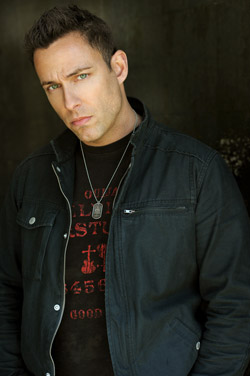
One of the most key components to any action adventure series is the stunt team and because SG1 and Atlantis were running concurrently, they needed a separate stunt team for Atlantis. James “BamBam” Bamford was the stunt coordinator for the whole five years Atlantis ran for. BamBam as he went by, worked closely with all the lead actors whenever they did any stunt work, he was the person who trained Rachel Luttrell in her stick fighting. When they did any rehearsals BamBam would video them and actually cut them together to show to the director how the fight could be shot and how it could turn out. The stunt team were top notch and committed to every single stunt no matter how much it hurt them. When shooting the episode Sateda, the stunt double for Jason Momoa was thrown into a metal door and fell down onto real brick and rolled onto solid concrete. Because of the costume the stunt man wasn’t able to have much padding either. He did that several times for the shot and after one take the crew thought he had badly injured himself because of how hard he hit the ground but he just stood up and asked if they needed another take. The stunt performers were the toughest people on the whole shoot, Rachel Luttrell talked about how she was scared of her stunt double at times because of how tough she was.
In the Season 3 finale there was a huge set piece stunt that involved exploding glass and a rope pull of the stunt woman who was doubling for Torri Higginson. The stunt had been rehearsed several times and they had it all set and perfectly rigged. The double would be pulled back as the glass blew and would land safely on a large crashmat. However, when they performed the stunt with the glass explosion, because the glass was blowing inwards it covered the crash mat that the stunt woman was being pulled towards. Thankfully the rigger pulled on the rope at the last second to prevent her from landing on the crash mat. This was the focus that these guys had- if that rigger had not noticed the glass landing on the mat and reacted instantly, the stunt woman could have been seriously injured. BamBam commented on how proud he was of his team constantly but that day the rigger got a lot more kudos than normal and deservedly so.
The Visual Effects Department on Stargate Atlantis were a lot of the same team that worked on SG1. The city of Atlantis was a 100% computer-generated composition and they went all out on the VFX of the city. They composed the city of 4 million polygons which at the time was feature film levels of Visual Effects and the sequence of Atlantis rising from the ocean floor was the most expensive visual effect in the pilot episode. They wanted to make an impact with what kind of visual effects we could expect from the series and they made an impact. I remember being blown away by the sequence when I saw it for the first time when the episode first aired in the UK. The way the water was thrown in the air by the city’s rapid ascent to the surface and even the subtleties in the effect of the water running down the side of the walls once it had risen. The physics of the situation were even accounted for as you see in the establishing shot of the city on the surface a wave of water moving away. It was incredible and it still is incredible to see. The marvellous VFX work didn’t end with the city rising, consistently throughout the series the VFX team pushed the boundaries of what was possible and did things that had never been done on TV before including creating a ginormous CGI storm for the two part episode The Storm and The Eye and in the season 3 finale, First Strike, a one minute long complete CGI shot which included a moving camera shot which is incredibly difficult to do in CGI.
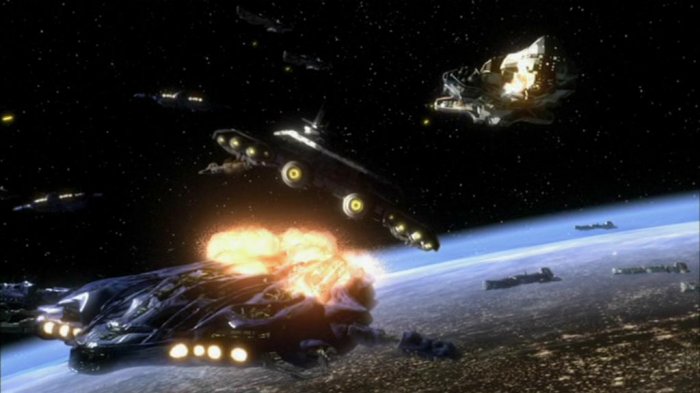
The production design on the series was top notch, they designed a new style of Stargate for the series and an intricate and detailed practical set for the Atlantis base. The Atlantis set cost $2 million to create and contained $70,000 in lighting alone. Where the SG1 gate was constructed of fibreglass the Atlantis gate was made of rubber. They also had to create a ship that would be able to travel through the Stargate itself. It was decided that the ship would have engines that could retract inside the ship itself in order for it to fit through the Stargate. For the Wraith vessels the production team opted for a more organic design, it was creepy and reminiscent of Alien. The surfaces looked like a living organism and had a really icky feeling to them which was how they wanted the audience to feel whenever they were aboard the Wraith ship. The production design was incredible on the series as each week they managed to give the series a theatrical feeling in the design, nothing felt low budget about the design and it was impressive to see each week.
Throughout the course of the series all the main cast members of SG1 appeared in Atlantis, due to financial issues neither Carter or Teal’C could appear in the pilot episode of Atlantis. However, they would go on to appear later on in the series with Amanda Tapping even joining the Atlantis series as a regular in season 4. When she joined Atlantis she commented about how she was now the Don S Davis of Atlantis and how much she missed going off world. Tapping was approached by writers Joe Mallozzi and Paul Mullie because they wanted the new head of Atlantis to have both a military and a scientific background. Samantha Carter was the perfect character for what they needed and to their joy Tapping accepted the offer. The writers had a lot of fun writing Carter’s interactions with the rest of the Atlantis team, most of all though they really enjoyed writing the scenes with Carter and McKay because of their prior interactions on SG1.
Richard Dean Anderson guest starred on three episodes of Atlantis in season 3, The Real World and The Return Parts 1 and 2. This was because he came up to shoot some scenes for the 200th episode of SG1 and wanted to hang around for a bit and shoot more than a brief cameo, there wasn’t anywhere they could fit O’Neill into the SG1 episodes but they came up with a way to write him into Atlantis. The writers also felt that putting O’Neill in Atlantis would be more interesting and wrote an elaborate underwater stunt for Anderson in The Return Part 2. It didn’t hurt that his prescience on the series would give the ratings a boost. When Michael Shanks guest starred in the season 5 episodes, First Contact and The Lost Tribe the writers put him and David Hewlett together in a lot of scenes and realised that because of how fast they were delivering their lines the scripts needed a higher page count than normal to compensate for the speed in which they talked.
Beginning in season 3 the writers wanted to develop the relationships between all the characters a bit more putting them in more social environments for scenes. This helped build up the character’s friendships and made them more human, the episode Sunday focused on this aspect a lot and because of that the heart-breaking final scenes had much more of an impact to them. The added social elements to the series was one of the things that separated Atlantis apart from SG1, it felt like a different show but it was still similar enough that you knew it was in the same universe. These were the reasons that made it such a great spin off, it wasn’t just redoing the same things as SG1 did.
When Dr Beckett was killed off, they needed a new medical doctor to fill his shoes and they got that in the form of Dr Jennifer Keller. Jewel Staite had portrayed a Wraith in the season 2 episode, Instinct, and because she had impressed the producers so much in her first role using prosthetics they wanted her to join the show as a regular. Staite had experience of Sci-Fi having starred in the Joss Whedon series, Firefly, and the feature film follow up, Serenity. Keller was written as a character who starts out very unsure of themselves and gradually over time gets more and more confident. She also became a love interest for McKay, that was never the original intention of the character though. Staite originally wanted her character to get into a relationship with Ronon because as she put it, “Keller has a crush on Ronon because she has, you know, eyes.” However, the chemistry between Staite and Hewlett worked so well and in the episode Trio they really were able to showcase that.

As the series went on Keller became more involved in a lot of the episodes interacting with all of the main cast. She also got into a few action scenes including some very intense fight scenes and stunts in the episode, Missing. There was a particularly intense sequence in the episode that involved a rope bridge which Keller had to cross. Staite talked about shooting that sequence in an interview and she said that she felt like she was getting a wedgie in six different places from the harness. That episode helped her and Rachel Luttrell bond though because they were working closely together for 12-hour days and carpooling to and from the location.
They introduced the Replicators into the Atlantis series in season 3 as a way to fully explain where they came from. From SG1 we already knew that the android Reese created the Replicators but who created her? From what is established in Atlantis we can deduce that the person who created Reese is one of the Ancients who returned to the Milky Way Galaxy. The Replicators would become a substantial threat throughout their appearances in Atlantis to the point where humans and the Wraith would actually join up to fight them. The Replicators of the Pegasus Galaxy were a different breed, they had been around for thousands of years evolving more and more which made them a much bigger threat than the other Replicators that had been encountered.
In the season 2 episode, Michael, the writers created a character who would end up becoming one of the major players in the Pegasus Galaxy all the way up to the final season. Michael Kenmore was originally designed as a one-off character; however, Connor Trinneer impressed the producers so much when they watched the dailies, they decided to bring him back. The character of Michael was extremely interesting because it posed the question of how far we could go to fight the enemy and did we have the right to go as far as we did. A serum that was supposed to turn the Wraith into humans was tested on a Wraith they captured and the consequences of that. The episode played out like a mystery of who Michael was with the reveal at the end. It was a masterfully put together episode and thanks to an incredible performance from Trinneer set up a long running arc. Michael was the wildcard character, neither Wraith or human, he was a hybrid and with that he was more dangerous than either of them. Trinneer spoke in an interview about how surprised he was that he was able to convincingly portray the character as it was unlike anything he had ever done before.
Michael was not the only Wraith who would return multiple times. Christopher Heyerdahl throughout the first season had portrayed Halling, an Athosian and one of Teyla’s close friends. In season 3 he returned to portray a Wraith by the name of Todd who would become a regular recurring character on the series. Todd was created to show that the Wraith are actually more complex a species than the life sucking aliens we had seen up to that point and to show that there was more to them. The character was popular and Heyerdahl impressed the producers in the role that they decided to bring him back several times and through the character of Todd they could explore more about the Wraith which included a deep look at how the Wraith society functioned. The character would ultimately become an ally as long as it suited his best interests, a Wraith that you could half trust, which was the best you could hope for when it came to trusting Wraith.
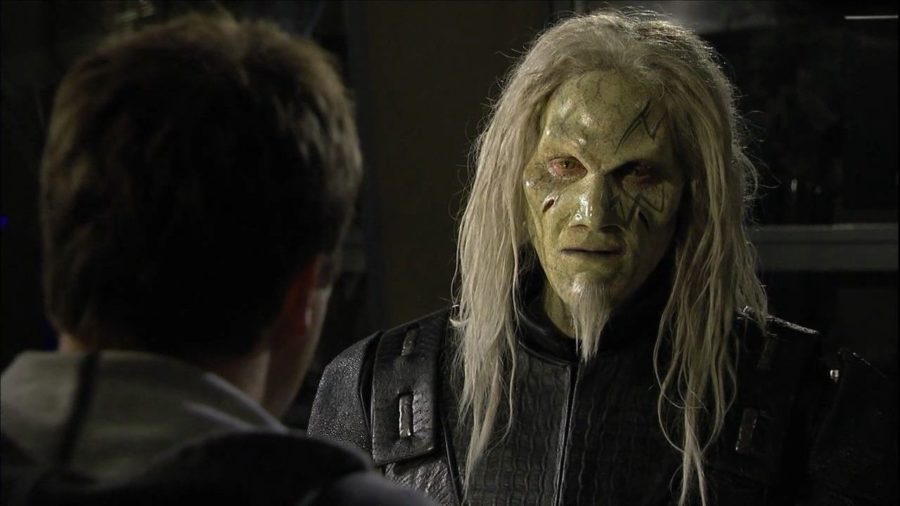
For the final season Colonel Carter was replaced as the commander of Atlantis with Richard Woolsey. Woolsey who had started out as a one-off character on an episode of Stargate SG1 had come back several times over the course of the series. He was a bureaucrat who felt that the rules had to be followed precisely to the letter. Once he was in the position of making the decisions though he very quickly started to realise that life as the commander of Atlantis was never so cut and dry. All his questioning of why they hadn’t followed protocol in this situation or that situation would be turned back around on him and he would come to realise that in the real world the rules have to be bent, stretched and even at times broken in order to ensure the safety of the people under your command.
Woolsey was portrayed by Sci-Fi Icon Robert Picardo. Picardo who is best known for his role as the Emergency Medical Hologram in Star Trek Voyager is no stranger to Sci-Fi and has appeared in various Sci-Fi films and TV series over his career. Picardo had appeared in seven episodes of Stargate SG1 and six episodes of Atlantis before being promoted to the commander of the Atlantis base. The character very quickly assimilated himself into the Atlantis team and put his own stamp on how the base is run. There was an attempt to add more bureaucracy into the base, however that didn’t last very long. He did develop close bonds with most of the characters and in the episode Inquisition he defends Sheppard and his team in a court of law using his background as a lawyer. The episode ends with Woolsey and Sheppard sharing a cigar and a glass of Scotch celebrating their victory in a scene that is a slight parody of Boston Legal which stars James Spader, the original Dr Daniel Jackson. Picardo really liked the idea of pairing Woolsey and Ronon together in as many scenes as possible because their characters were such complete opposites, Ronon is a man of few words and a man of action where Woolsey is a man of many words but little action. The contrast in characters worked well from what we did see of them together.
Stargate Atlantis was cancelled in August 2008 and a follow up film entitled Stargate: Extinction had been announced by MGM. Joe Flanigan found out about the cancellation whilst eating lunch in his trailer on set. Because of the news of the cancellation came during the production of season 5 the writers could make sure that it didn’t end on a cliffhanger. Joe Mallozzi had the idea to shoot a two-hour opening episode to season 6 as part of the season 5 run which could have been edited into a film if they couldn’t find someone to pick up the series for a sixth season. He regrets waiting for permission from MGM instead of just going ahead with it as the follow up film that was announced never happened. The last episode they shot of the series was Vegas and, in that episode, the alternate John Sheppard character dies. This was the last shot they took for the episode and because of that the last shot filmed for the whole series was the main character dying.
After the cancellation and when it became clear that Stargate: Extinction was not going to happen Joe Flanigan decided that he was going to do something about it. Not content with the series ending he decided to try and get the production back up and running himself. Flanigan didn’t feel like that the film was ever going to happen and that it was a way to try and satisfy the fans that he felt had been ostracized by the announcement that Stargate Universe was going after a younger sexier audience. He set up a deal with MGM to lease the Stargate franchise for ten years, part of the plan was to produce season 6 of Stargate Atlantis. The funding for the project had been secured and they had worked out that they would shoot the series in Europe as it was cheaper and just before the deal was signed MGM filed for bankruptcy. The project was thrown into upheaval and Flanigan had to start all over again with the people who now owned MGM’s backlog, Spyglass Entertainment. He went through the entire process with them from scratch and they weren’t interested, they seemed more interested in rebooting the original film with Roland Emmerich and Dean Devlin. Flanigan was not pleased with this outcome as he felt that the Stargate franchise had extended way beyond the original film. He felt that even though one season of Atlantis made more money than the original film did there was more of a prestige and glamour attached to films which angered him as that was not what the audience wanted, they wanted more of the series.

Stargate Atlantis was more than just a spin off, it was a show that stood on its own and connected to a larger universe. The series had characters that stood apart from the characters of SG1 and were not just copies of the SG1 characters. The series could be watched on its own or alongside SG1 and I know people who first watched Stargate Atlantis before SG1 and were never lost. It was a series that combined high concept Sci-Fi, serious drama, exciting action and laugh out loud comedy into one giant package. The cancellation of the series was really the beginning of the end of the franchise as many fans were angry with the cancellation. They were made to feel like they didn’t matter when they announced that the next Stargate series would be going for a younger sexier demographic. The fans also felt that Atlantis was cancelled to make way for Stargate Universe. Whether or not it was or it wasn’t is something that only a few people will really know the truth to, the producers claim it wasn’t but not many believe this claim. The announcement of going for the younger demographic is one of the biggest reasons that many do not believe that Stargate Universe had nothing to do with the cancellation. Despite the cancellation Atlantis got ninety-nine fantastic episodes under its belt and is the only Stargate series that has had the complete series released on Blu-Ray. It sits proudly on my shelf and throughout the whole process of writing this I’ve been itching to get the set back down and watch it from the beginning.
NEXT WEEK: PART 4: REACHING OUT INTO THE UNIVERSE AND BACK – STARGATE UNIVERSE, STARGATE ORIGINS AND THE LEGACY!
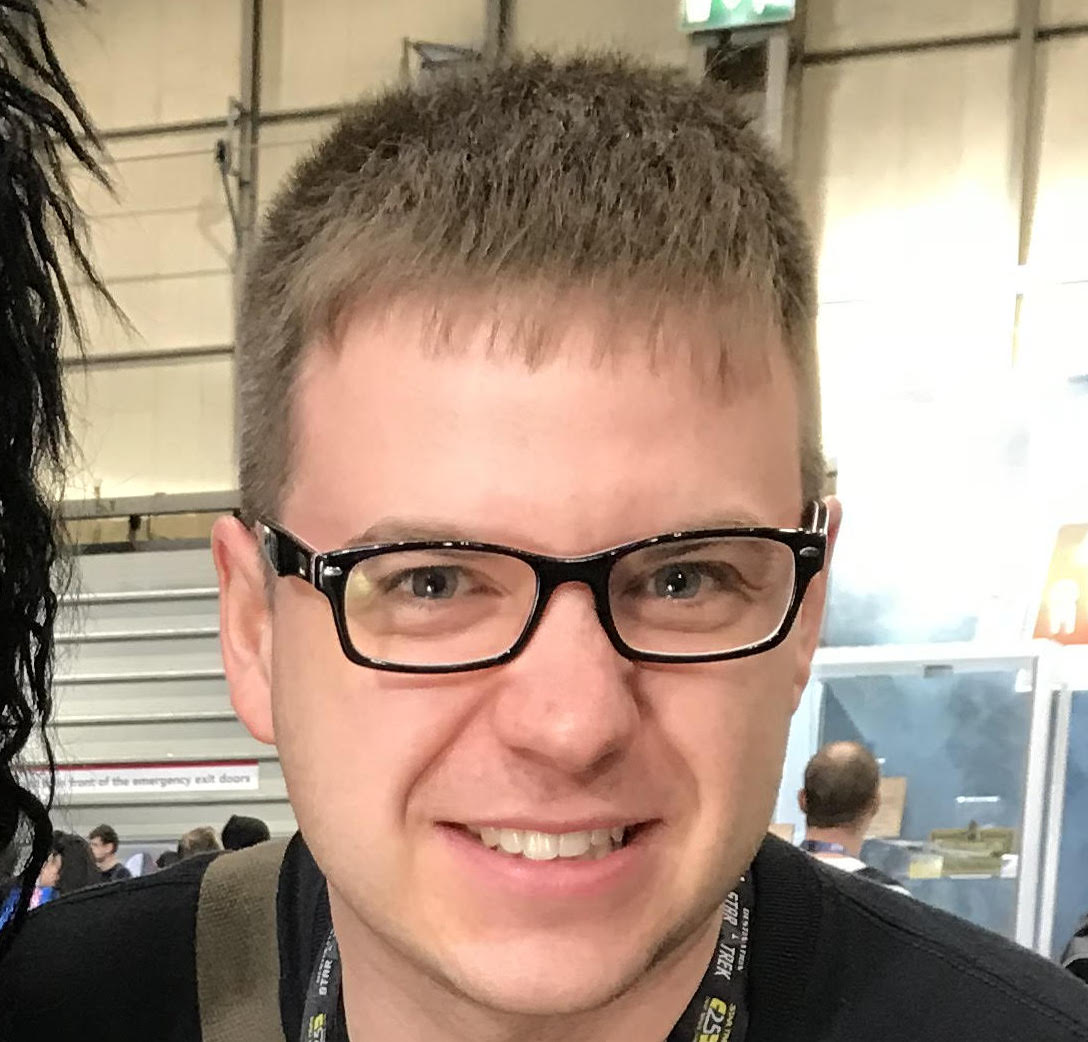
Matt is a huge film and TV buff who studied film and moving image production at university. In his spare time he enjoys reading comics and books, the occasional gaming session and writing novels.

